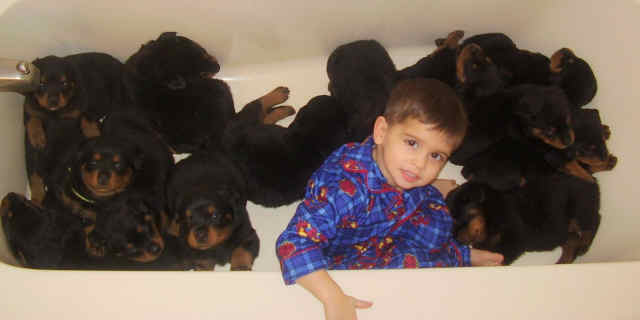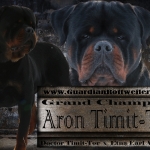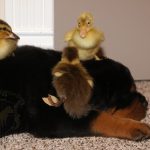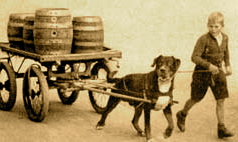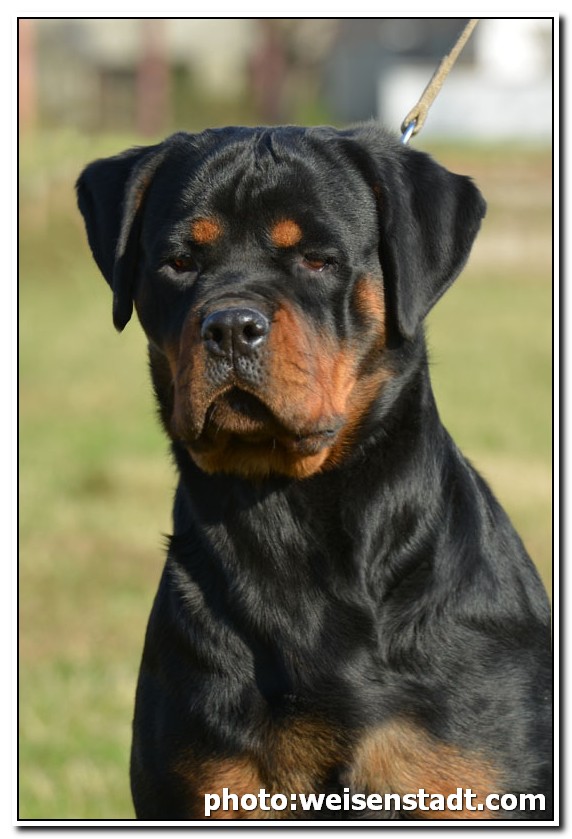Reproduction in the Rottweiler
MALE REPRODUCTIVE ORGANS

The male’s reproductive organs consist of the penis, which is kept protected by the prepuse and the testicles, ductus or vas deferens, and prostate gland. There is also a bone in the penis called the “os penis” which hold the penis shape to facilitate copulation. In the human male, the penis must first become erect before intercourse takes place, however, in the dog, he will penetrate the female before becoming erect, and this bone makes that possible. Once he has successfully entered the female, his penis will then become erect, and the bulb like glands at the base of the penis will become engorged, locking him into the female. This is necessary because unlike with human males, sperm is not readily available. In humans the testicles produce sperm constantly and is moved to the epididymous. This allows a human male to release all the stored sperm at the point of orgasm. Dogs do not have this organ. They are required to “pump” their sperm directly from their testicles. This process can take up to 20 minutes. By locking the female in place, it prevents her from leaving before he has completed.
Males reach sexual maturity at about the same age as a female. A male, or stud, does not have a “cycle” like a female. They are receptive to breeding anytime there is a female in heat, and sometimes even if she is not. (Again very similar to men ;-)’
Before sexual maturation, the testicles of a male may not yet have descended, and may still be held in the abdominal cavity. They will usually “drop” by 6 months if not sooner.
FEMALE REPRODUCTIVE ORGANS
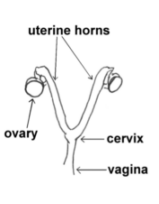
A female may reach sexual maturity as early as 6 months, but she is not yet mature enough for breeding. Her body, as with all Rottweilers and large breed dogs will not finish growing until 24 months of age The major elements of a female canine are much like those of all mammals. She has a vaginal opening, a cervix and ovaries for her eggs. The biggest difference is the uterus. The canine uterus is Y shaped, where as that of a human is pear shaped. The top of the “Y” is where the puppies will develop. Just like with humans, the eggs produced in the ovaries and then released into the fallopian tubes when mature. The 2 fallopian tubes dangle over the top of each arm of the Y and are each attached to the 2 ovaries. The eggs are not released all at once by the ovaries to the fallopian tube. The females are multiple ovulators, which means that they make several eggs, and release them over a period of several hours, or even a day or more. This helps to contribute to the ability of a female to have several “conception” dates as well as multiple sires of her puppies. We will discuss this further down on this page. It is the female who determines the number of puppies to be born, and the male who determines the sex.
The vagina inside the dog is not straight either. The first 1/3 of the vagina slants upwards at a 45 degree angle and then it levels out and continues to the cervix. The cervix remains tightly closed until the female is ready to deliver her puppies. This helps prevent infections entering the uterus. The opening to the bladder is located inside the vagina as well. It is a tiny urethral opening, which allows the urine to run out of the vagina. Inside the vagina is a very strong ring of muscles, placed at about where the angle of the vagina changes. Just as nature has provided for the male to remain “stuck” inside the female, the female also has a method of retaining the male. Once the male has entered the vagina, the female tightens these muscles to hold the penis in place. This ‘tightening action’ creates what is commonly known as a ‘tie’.
THE FEMALE CYCLE
A female Rottweiler will generally go through “puberty” and have her first heat cycle around 12-18 months, although there are some that will have their first cycle as early as 6 months. THIS DOES NOT MEAN THAT THE DOG IS OLD ENOUGH TO BREED! It is the same with humans, just because a child “can” get pregnant, does not mean they are ready physically or mentally for the challenges of pregnancy, birth, and caring for the baby. Large breed dogs do not stop growing and developing until 24 months of age. Breeding a female too young will usually result in a much higher birth defect rate and can permanently stunt the growth of the female. She will also have a higher rate of “rejecting” the pups at birth as she will not be mature enough to care for them.
A female will typically cycle every 4-6 months, with some females taking much longer between cycles. Just like every woman will tell you, it is NOT an exact science. Every female is different, and there are even variations within the female–meaning she can have different lengths of and between her cycles at different stages of her life. Some females also possess the ability to “synchronize” their heat cycles with other females living with or near her. This is usually a dominant female and it meant to ensure the survival of HER young. There are four stages to her cycle.
The first is Proestrus. This is the “onset” of her heat cycle. During this time you will see physical changes in your female as well as behavioral changes. The female will usually become “frisky” or “flirty” with the males, although she will not yet allow them to mount her with a successful tie. She will become quite swollen in the vaginal area. (When she passes through “puberty” and her vagina becomes swollen with her first heat cycle, it will decrease in size after she finishes her heat cycle, but it will never go back to her “puppy size”). The female will also begin to drip blood at this time. This is an advertisement to the males. In a very clan female who constantly cleans herself and her “environment” you may not notice the blood at first, so look for her behavioral changes as well as the swelling of her vagina. Most females will also “blow” their coat just before coming into season. The males will show much interest in her. A younger or inexperienced male may even try to mount her during this early stage, but she will not allow it by either passive resistance–sitting or laying down, or she with a persistent male, she may even growl or snap at him. A more experienced male will begin “testing” her periodically to see if she is ready yet. He will lick her vaginal area or even her urine and “analyze” it internally in his lab ;-)’ This stage can last 5-9 days.
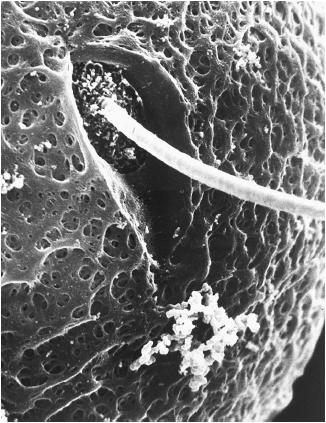
The next stage is referred to as estrus. Estrus will typically last 5-9 days also and will be the correct time for breeding the female. The male, who has probably been following her and “testing” her daily will be very strongly attracted to her at this point, and she should be equally receptive to him. She will begin “flagging” him. This is where she either backs up to him, or waits until he comes behind her and they she will move her tail to the side. For a male that does not show enough interest, she will mount him as well in an attempt to arouse him. This is usually when the dogs will “tie” or become locked with her vaginal muscles tightening around his swollen penis. ATTEMPTING TO SEPARATE A MATING PAIR BY FORCE THAT ARE ALREADY TIED WILL CAUSE SERIOUS DAMAGE TO BOTH THE MALE AND FEMALE, AND WILL NOT PREVENT PREGNANCY. The male has already delivered his semen during the initial thrusts of intercourse. You also want to make sure to NEVER leave a mating pair alone especially if either are “new” at this. Often the female will become quite distressed when she realizes she cannot escape fro the male and will yelp, attempt to forcefully escape or even turn on the male. You must keep her calm and reassure her because the male is helpless. Bleeding from the vagina will slow down and may even be absent during eutrus. Her eggs are released from the ovary and travel down the oviduct. Ejaculation will occur and sperm cells will enter the uterus and make their way to the oviduct, where their union with the egg will result in fertilization. It is important to note that a “tie” is not required for fertilization and even if they do not have a successful tie, the male may have already delivered enough semen during the “attempt.”
Following estrus is the diestrus period. During this time, the female will not longer be receptive to the male and will refuse to “stand,” or refuse his advances. This stage will last until the end of the pregnancy, or in the case there was no pregnancy, it can last up to 80 days. In early diestrus, the embryos and their placentas attach to the wall of the uterus, from which they will derive their oxygen and nutrients, in much the same way as a human baby.
The final phase is Anestrus. This is the time between cycles and will differ from one female to another. During Anestrus, there should be no sexual interest from a male, and the female will not prohibit any “hanky-panky” from the male.
GESTATION
If the breeding was successful, the female will whelp, or deliver her pups in approximately 63 +/- up to a week. The first physical sign will be her vulva, or vaginal area. It will remain slightly swollen. Also, around 4 weeks after breeding, you will notice her nipples become more prominent and the hair around them will begin to recede. It is very important that she be on a good, quality diet during her pregnancy. We feed FROMM Large Breed Puppy to our pregnant and lactating females–the puppy food has higher fat and protein for her developing puppies. DO NOT ADD ANY VITAMINS (OR ANY MEDICATIONS) BY YOURSELF WITHOUT PERMISSION FROM YOUR VET. Too much vitamins A and D could result in birth defects as with many medications. DO NOT VACCINATE YOUR FEMALE AFTER SHE HAS BRED OR DIRECTLY BEFORE. This could result in encephalitis, or swelling of the brain in the developing puppies!
Often around the 3rd week, she may go off her food for about a week–similar to human “morning sickness.” Rarely, she may even vomit.
About half way through her pregnancy (around 4 weeks) you should increase double her food. After she whelps the litter, you will keep her on double to triple portions depending on how may pups she must nurse.
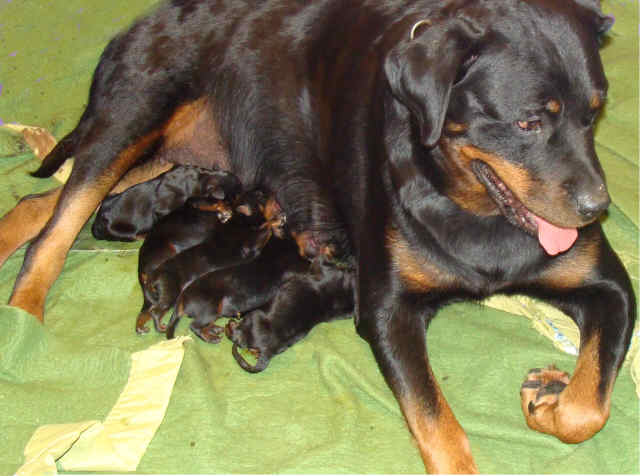
About 10 days before the pups are due, we will take our females in for an x-ray. This is will give us a good “guestimate” on the number of pups. (One time the vet though about 8 and Alexis had 13!! But at least we would have known if she stalled in labor after 4 pups, something was wrong.) Also about 10 days out, you will need to begin taking her temperature rectally, and find her “normal.” Typically, a dog is between 101-102.5, but every dog has their “normal.” Her temperature will drop significantly (below 100–usually about 98) 8-24 hours before the onset of labor. Most females will also go off of their food and water the day of or the day before labor begins as well. Again, terms like”most” and “usually” are to be used as a guideline only. We have one female who eats the entire time she is in labor and in between pups! We have another female who will drop in her temperature several times (just to keep us on our toes!) before the actual labor begins. It is VERY important to not leave you female alone as she gets this close to labor. Having one baby by yourself, without any complications is difficult enough–nearly impossible for several. You are only asking for heartache if you expect your female, especially a first time mom, to do it all correctly by herself. We stay with our “moms to be” constantly the last 2 weeks. We take shifts.
WHELPING

First and foremost, you must have a good whelping box (click for more information). You may either buy one, or build one yourself. The most important feature is the pig rail. For an animal that could be over 100 pounds one day, they are born amazingly small. It is too easy for the mom to squish one accidentally, and the pig rail prevents her from pinning one against the wall resulting in certain death.
You will also need:
many hand towels, or rags
• a thermometer
• a scale small enough to read ounces or grams
• a bulbous syringe (a baby “snot sucker”)
• different colored yarn or ribbon (for “labeling” the pups)
• dull scissors (they will clamp the umbilical cord as you cut it)
• dental floss (to tie the umbilical cord)
• a trash bag
• puppy formula (click for recipe) in case mom’s milk does not come in, there are too many
pups, or it is too small or weak to nurse
• “fat balls” (click for recipe) to feed mom if it is a long labor so that she can keep up her
strength
• a good book and a comfortable chair (although I am always in the box with mom most of
the time)
• and my daughter insists on her nail kit- she always gives herself and the new mommy a mani-pedi while waiting 😉
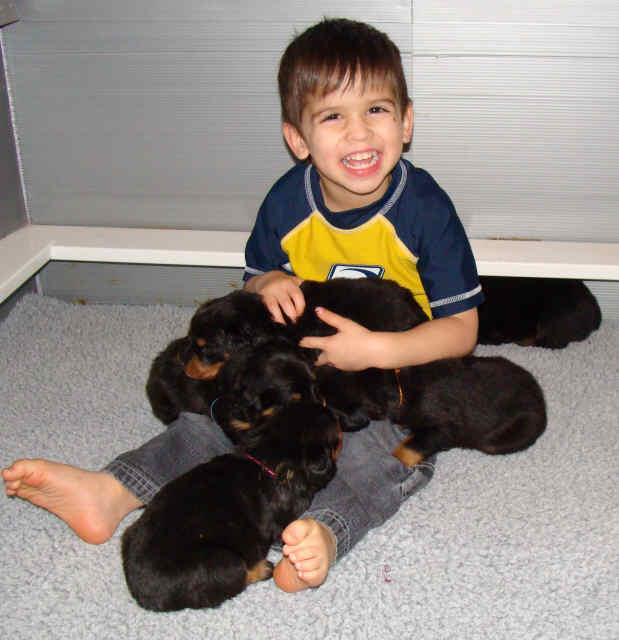
If your female has not exhibited any obvious signs of starting labor (drop in temperature or refusal to eat or drink) then look for the more subtle signs. She will begin nesting (digging or scratching at her blankets, piling them up or moving them around–she instinctually know she must prepare a good place for her pups). She will also pant heavily once labor has begun as well as pace and/or shifting positions constantly as though she cannot get comfortable. She is now in stage one of labor. The contractions are painful and confusing for your female. Some dogs want to be left alone. All of our females desperately want to be with us. I had one female break the door because I closed it to give her some peace from my screaming baby. I obviously passed my son to dad and went to sit with my baby girl. Some females will whine, other will grunt, and some will just occupy themselves with their nesting and pacing. The first stage of labor is the longest and typically (again, no “set in stone” number) lasts 6-18 hours. By the end of stage one, her cervix will have completely dilated for the puppies to pass.
During the second stage of labor uterine contractions will be stronger and closer together. As this stage progresses the placental water sacks break and a straw-colored fluid is passed. Pups usually appear every half-hour to hour, although some may come back to back. As the mom delivers the pups let her lick the puppy clean and bite off the umbilical cord. It is important to let the mother do this, if she will, because through this process she bonds with her puppies and learns to recognize them as her own. The rough licking of the mother stimulates the puppies to breathe and improves their circulation. She will probably eat some of the afterbirth as well. This is natural. Not only is it very rich in iron and protein, but it is natures way for her to keep her environment clean so that predators will not be attracted to her pups. Some moms do not have the natural instinct to tear the sac open, or are perhaps too exhausted to even currently pushing another puppy. If she does not tear away the sac and lick the pups to stimulate respiration, you must open the sac open, clear all fluid away from the pup’s nose and mouth (with your bulbous syringe), and vigorously rub the pup to stimulate breathing. Next you must tie the umbilical cord off about 1/2 and inch away from the pups belly and then cut another 1/4 or so after the knot. After you have successfully cleaned and somewhat dried the puppy, give it a quick weight check and physical, assign him/her a color collar and log all of her information in your book. You will keep giving her a check-up and weigh in every 12 hours for the next week, then daily after that. This will help to ensure that she continues to grow and does not develop “failure to thrive.”
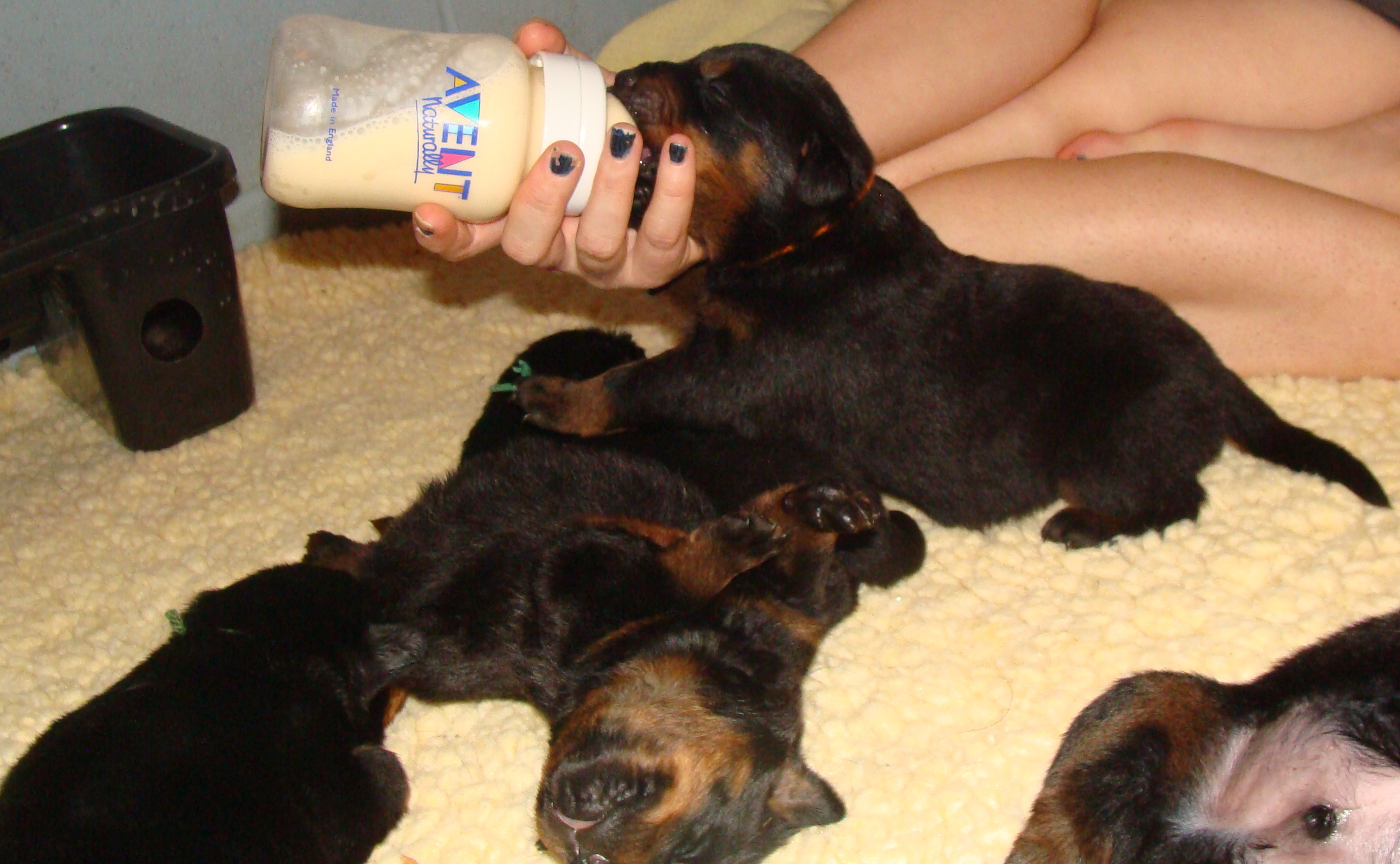
After you have given the puppy a check-up, you must immediately get him to nurse. For a puppy who is reluctant or weak, you may need to manually express a small amount of the mother’s milk on the nipple and gently force the pups mouth over it. The mother’s first milk, or colostrum is vital to the puppies. Not only is it rich in energy and nutrients (because being born is hard and exhausting for the pup too!) but it also contains the life saving antibodies. Nursing also plays an important role for the mother. It stimulates contractions so that the rest for her pups can come.
It is not uncommon for the mother to take rests during labor and up to four hours can pass between some puppies. If more than four hours have passed without a puppy and you are certain more puppies (again, this is why an x-ray is so important) are present take the dog to a veterinary hospital immediately. She may have stalled in labor and the rest of her puppies are at great risk as well as the mom. You must also get immediate medical attention if the mother strains forcefully for over an hour without producing another pup as one may be stuck in the birth canal. If you see the rear legs of a puppy protruding from the dog’s vagina you can assist the mother by gently pulling the puppy in a downward and rearward arcing motion as she contracts. You must do this very gently because puppies are fragile and easily hurt. It is normal for many puppies to be born rear feet first and we find that this happens about 50% of the time.
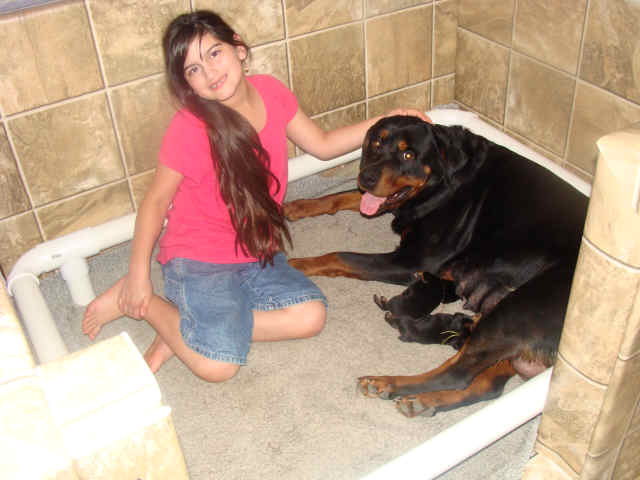
During the third stage of labor, your mom’s uterus should contract fully and expel any remaining fluids or afterbirth. Typically the placenta are deliver with or immediately after each puppy, but if there is anything left, it should expel during this time. The mom will need to get a vet check the next day to ensure everything delivered and she is doing well. The vet will probably check the milk supply as well and let you know if there are any nipples that are not functioning or not producing well. If you plan on docking the tails on your puppies, you will do that at this check up as they should be done within 24-48 hours after birth.
Your female will have a generous amount of bloody discharge overt he next several weeks. However, if it has a strong odor or is pus-like especially in combination with a fever, than she could have a retained puppy or placenta and have an infection. Consult with your vet if you have any concerns. Her behavior should be happy and alert, affectionate and attentive to her puppies, She should have a very hearty appetite as her body rapidly converts everything she eats into milk. Check her milk supply often, and be aware for signs that her pups are not getting enough–crying constantly, unable to sleep, skinny, or lethargic. A newborn puppy needs to almost constantly eat and can become dehydrated and hypoglycemic (low blood sugar) very quickly–within hours it could die! It is also of extreme importance that the pups be kept warm via a heat lamp, dog warmer, or a heater in the room. Hypothermia is another fast killer for pups. You must make sure the mom drinks plenty of fluids as well or she will not have adequate milk supply. If there are too many puppies for her to nurse, then you should try to rotate them for at least the first 3 days so that they can get mom’s colostrum. If they must go on a bottle after this, then still try and rotate them into mom’s milk between bottles.
MULTIPLE SIRED LITTERS
For those that are unfamiliar with the breeding, cycles, and pregnancy of a dog, I would like to provide a brief explanation so that you may understand the term “duel-sired” or “multiple-sired.

When a female dog ovulates, she released several eggs, and not all at once. This differs from humans, as we typically release one egg. For each egg she releases, it must be fertilized by a sperm. So if she released 10 eggs, she will require 10 sperm to fertilize all her eggs. Every time a female is bred, she has the potential to become pregnant by having one or more eggs fertilized. Going with our example of 10–if she is bred on Monday, and 2 of the sperm are successful, then she will have the potential to begin developing those 2 puppies on Monday. Then she could be bred again on Wednesday, and possibly have 4 eggs fertilized this time. Then she could be bred again on Friday with 3 more eggs fertilized resulting in 9 of the 10 eggs fertilized and the possibility of 9 pups. Because the eggs can be fertilized at different times, the puppies can be at different stages of development at birth. Some puppies could be as much as a week behind their siblings, resulting with a puppy with “small” birth weight, that later develops into the largest adult. He was not genetically predisposed to be small, simply behind everyone at birth. Now, because a female can become pregnant every time she breeds during her ovulation (heat cycle) she has the potential to have as many sires of her pups as she is bred with, assuming that each breeds with her while she is receptive and the sperm are able to successfully penetrate an egg. Occasionally a breeder will “duel-sire” a litter if he is looking for a specific type of pup or to see how different studs produce with the same female. The reason this is not done often (intentionally) is because an honorable breeder must now DNA test the dam and all possible sire’s (if this has not already been done) as well as test each and every pup in the litter. It is possible that one sire was “potent” enough to father the entire litter (with one breeding a male with a good semen count may fertilize all the eggs, rendering subsequent breedings useless.), but since this is not certain, testing just one pup will not ensure correct parentage. Many “breeders” will multiple-sire regularly due to carelessness (not keeping the dogs properly separated while the female is in heat) or due to greediness–assuming that more sires will equal more pups. However, the number of dogs a female is bred with has no bearing on the number of eggs she will release. The breeders that have a multiple sired litter out of greed or carelessness with rarely DNA test (it is not worth the expense if money is your main objective. I purchased a dog a few years ago that failed his DNA test, likely because the litter was multiple sired and the “breeder” did not want the extra expense. It is several hundred dollars extra to register the litter when it is multiple sired as well as the the added expense of about $100+ per dog/pup for the DNA test. So that litter of 10 could set one back well over $1000.

Hopefully most of you know that Guardian Rottweilers is not “most breeders.” That is probably why you are considering one of our pups. I was raised with a solid moral compass by my grandmother and strive to please her as she looks down on me from heaven. I would never do anything to disappoint her or my Heavenly Father. I have also been burned by a few “breeders” over the years and would never want to be the cause of that frustration and betrayal for someone else. My dogs are my family. They are cared for as such, loved as such and treated as such. I expect every pup I send to a new home to be treated with as much love and respect as we give them here, and that relationship must start on a good foundation of respect an trust. When you get a GR pup, youth or adult, you are now part of the GR family.






